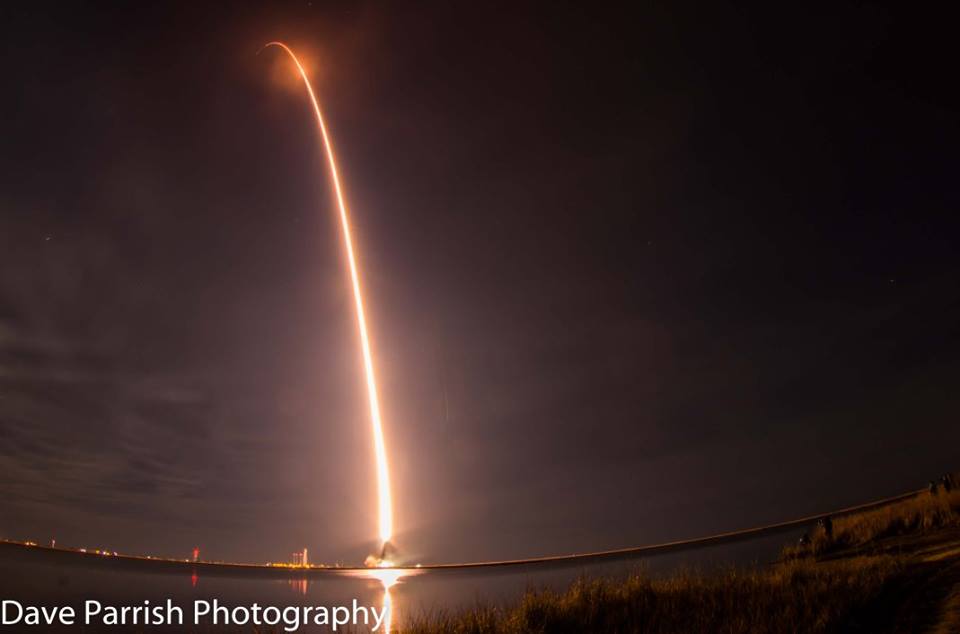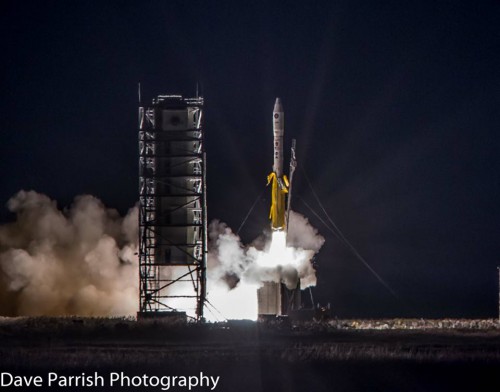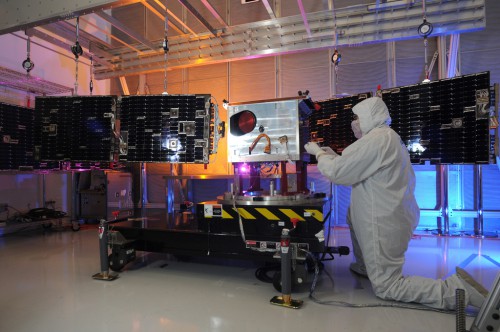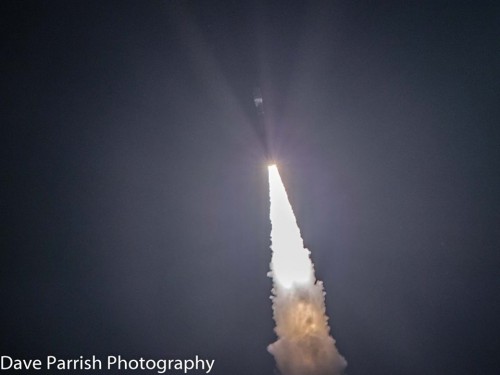
Slightly later than intended, Orbital Sciences Corp. has successfully flown its 25th Minotaur vehicle, with a spectacular liftoff from Pad 0B at the Mid-Atlantic Regional Spaceport (MARS) on Wallops Island, Va. Launch of the four-stage Minotaur-1 occurred at 8:15 p.m. EST Tuesday, about 45 minutes into a 105-minute “window,” and delivered the U.S. Air Force’s Space Test Program Satellite (STPSat)-3—part of the Operationally Responsive Space (ORS)-3 mission—into a 310-mile (500-km) circular orbit, inclined 40.5 degrees to the equator. Shortly thereafter, the process to deploy no fewer than 28 small “CubeSats” got underway, marking out yesterday’s flight as the largest number of satellites ever successfully despatched by a single rocket launch. However, the Minotaur’s record should not endure for long. According to present plans, it will be broken tomorrow (Thursday) when a Dnepr booster lifts off from the Yasny launch site in Russia’s Orenburg Oblast, carrying 32 discrete satellite passengers.
In spite of a 100-percent likelihood of acceptable weather conditions at the original 7:30 p.m. EST launch time, mission managers were faced with two key obstacles to overcome before the Minotaur-1 could be committed to flight. The first was a large “X-1” solar flare event, unleashed from the Sun early Tuesday and recorded by NASA’s Solar Dynamics Observatory. According to NBC News, the flare was not aimed directly toward Earth, but did trigger a temporary radio blackout at 5:26 a.m. EST. “It erupted from an active sunspot region called 1893,” the news agency noted, “and space weather experts suspect it may have produced a Coronal Mass Ejection (CME) … of solar plasma.” The Sun is presently at the peak of its 11-year cycle of activity and X-class flare events are the most powerful known type of solar storms. By early Tuesday evening EST, the space weather issue relating to the X-1 flare had been cleared and reclassified as “Green” (“Go”).
However, there remained a technical issue with the downrange tracking station at Coquina, N.C., which experienced difficulties with a backup transmitter for the Minotaur’s Flight Termination System (FTS). The latter is typically transferred to internal power and armed at T-10 minutes and carries the ordnance to destroy the vehicle in the event of a major accident during ascent. In the meantime, standard steps to configure the Minotaur for flight proceeded normally, but by 6:30 p.m. EST the Coquina issue forced mission controllers to hold the count at T-60 minutes until its resolution. Finally, at 7:15 p.m., the count resumed, but even the final minutes were marred by the need for the U.S. Coast Guard to shoo an unauthorized vessel out of the launch danger waters.

At 8:05 p.m., the FTS was transferred to internal power and armed. Avionics switched to internal power shortly afterward, and at T-5 minutes the Minotaur’s autosequencer assumed primary control of all vehicle critical functions. A descendent of the Minuteman-II intercontinenal ballistic missile, the Minotaur-1 configuration stands 63 feet (19.2 meters) tall and—including Tuesday’s launch—has now completed 11 successful missions since January 2000, with the capability to inject payloads weighing up to 1,280 pounds (580 kg) into low-Earth orbit and up to 730 pounds (331 kg) into Sun-synchronous orbit. Six of its flights have been staged from Space Launch Complex (SLC)-8 at Vandenberg Air Force Base, Calif., and five from Pad 0B at MARS.
The vehicle has delivered a variety of small military payloads into orbit for purposes ranging from reconnaissance and infrared missile-plume observations to automated rendezvous and proximity operations and from evaluations of advanced imaging and communications technologies to meteorology, climatology, “space weather” monitoring, and bacterial research. Significantly, it has a proven track record in providing near-term solutions to military requirements, successfully launching the TacSat-2 mission less than seven months after the contract award and demonstrating an ability to progress from payload mating to launch in less than six days. All four stages for last night’s launch were solid-fueled, with the lower two stages consisting of hardware from decommissioned Minuteman-II missiles and the upper two stages utilizing hardware from Orbital’s Pegasus air-launched booster.

Liftoff got underway with the ignition of the Minotaur’s first-stage engine at 8:15:00 p.m. EST, generating a total propulsive yield of 210,000 pounds (95,250 kg) and a fast climb away from the Pad 0B complex. Two seconds after leaving the pad, the rocket commenced a computer-commanded pitch and roll program maneuver to establish itself onto the proper flight azimuth for its ascent to orbit. At T+38 seconds, it encountered a period of maximum aerodynamic turbulence—known as “Max Q”—on its flight surfaces. The first stage engine shut down at 61.3 seconds into the flight and the SR-19 second-stage engine picked up the baton, pushing the vehicle uphill with a thrust of 60,000 pounds (27,200 kg) for 72 seconds and separating a little over two minutes after liftoff. Next came the Pegasus-derived Orion-50XL of the third stage, which fired for 73 seconds with an impulse of 26,600 pounds (12,000 kg). During this period, the Minotaur-1’s payload fairing was jettisoned, exposing the ORS-3 payload to the near-vacuum conditions of space for the first time.
By the end of third-stage flight, as described by NASASpaceflight.com, at about 8:18 p.m. EST, the vehicle was already 290 miles (467 km) downrange of the Virginia launch site, at an altitude of 150 miles (240 km) and traveling in excess of Mach 20. The vehicle coasted for about five minutes, ahead of the separation of the third stage at around 8:24 p.m., and ignition of the fourth stage’s Orion-38 engine for 68 seconds. Finally, at 8:27 p.m., the 360-pound (165 kg) STPSat-3 payload—part of the ORS-3 mission—separated from the vehicle. Developed by the Air Force’s Space Test Program, it was built by Ball Aerospace and Technologies Corp. of Boulder, Colo., and is equipped with five instruments to study plasma energies and densities, characterize Earth’s ionosphere and thermosphere, and monitor changes in solar irradiance in the upper atmosphere. STPSat-3 also carries the capability to de-orbit itself within 25 years.
According to Ball Aerospace, STPSat-3 was built in less than seven weeks and was actually completed ahead of the final selection of its five payloads, thereby demonstrating the flexibility of the hardware. “With a full initial payload manifest, Ball proceeded to build the STPSat-3 bus in only 47 days,” the company noted, “completing the spacecraft in January 2011. In May 2012, the Air Force selected a different payload manifest for STPSat-3. Only 11 months later, the Ball team had integrated and tested the new payloads and STPSat-3 was ready to ship.”

Known as “The Enabler Mission,” ORS-3 has been in development for some time and is intended to evaluate space-based tracking technologies and an autonomous Flight Termination System. At present, radar tracking instruments and optical sensors are employed to track ascending rockets and, if necessary, destroy them in the event that they should substantially depart from the planned trajectory. “We’re working really hard on what we call space-based range systems,” said Peter Wegner, until February 2013 the director of the ORS Office at Kirtland Air Force Base, N.M., quoted by Spaceflight Now. “The idea behind space-based range is you literally take all that range infrastructure, which is time-consuming and costly, try to streamline it and put it on the rocket.”
After the separation of STPSat-3, the deployment of the record-setting payload of CubeSats from their dispenser lay ahead. “The Minotaur’s upper stage then executed a pre-planned collision avoidance maneuver,” explained Orbital Sciences in a post-launch statement, “before starting deployment of 28 CubeSats sponsored by the ORS Office, the U.S. Air Force Space and Missile Systems Center’s Space Test Program and NASA’s Educational Launch of Nanosatellites (ELaNa) Program.” In its pre-flight status reports, Orbital anticipated the period from liftoff to delivery of the satellites to require no more than 12.5 minutes, with the official press kit detailing “Payload Sep” at T+734.05 seconds, or 12 minutes and 14.05 seconds after launch.

The 28 small CubeSats, together with STPSat-3, rode into orbit and were despatched from an Integrated Payload Stack. Of particular note is TJ3Sat, developed by students from Thomas Jefferson High School for Science and Technology in Alexandria, Va., which Orbital describes as “the first satellite built by high school students to orbit the Earth.” Inaugurated in December 2006, the TJ3Sat project carries as its primary mission a drive to “provide educational resources to other K-12 educational institutions and foster interest in aerospace through the successful design and flight of a CubeSat.” Orbital funded the purchase of the satellite hardware, and its staff mentored the students with engineering support. Once in orbit, students and other users from around the world will be able to submit text strings to be uploaded to the TJ3Sat website. Approved text strings will be transmitted to the satellite and its Text Speak module will convert them into voice signals for relay back to Earth via amateur radio, using an on-board Stensat radio.
“Since the beginning of the TJ³Sat program, Orbital has purchased flight hardware and contributed mentors and advice throughout the process, as well as assistance with final testing prior to launch,” said Mr David W. Thompson, Orbital’s President and Chief Executive Officer. “We are thrilled to see the hard work and dedicated efforts of the students at Thomas Jefferson High School come to fruition and look forward to the educational benefits this satellite will bring to other students around the world.”
Last night’s launch, which was executed under a Federal Aviation Administration (FAA) license obtained by Orbital Sciences through the FAA’s Office of Commercial Space Transportation, demonstrated a commercial-like approach to government launches in an effort to reduce overall costs. Through this mission, Orbital also supported the development of new technologies for launch and range improvements including automated targeting, range tracking, and flight termination systems.
With thanks to Mike Killian, Dave Parrish, and Chris Cook for providing imagery in the preparation of this article.
Want to keep up-to-date with all things space? Be sure to “Like” AmericaSpace on Facebook and follow us on Twitter: @AmericaSpace



